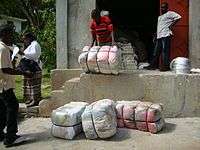Pepe (Haiti)

In Haiti, pepe may refer to secondhand clothes that are commonly worn by its population. These clothes are usually sent from the United States.[1] The Haitian textile industry has suffered due to the widespread popularity of pepe.[2] There have even been discussions about banning the import of pepe.[3] However, this is unlikely since the general population continues to wear pepe, which include many brand names that otherwise would be inaccessible.[3]
The import of pepe began in the 1960s, during the Kennedy administration, leading to the moniker "Kennedy clothes".[1] Since the 1980s, hundreds of tons of pepe has been imported, usually packaged in huge bales.[4] The clothes are so affordable, that a used boy's t-shirt from the United States could be sold for as little as thirteen cents in Haiti.[1] Furthermore, at an affordable cost, local seamstresses make modifications to the clothing.[4]
In recent years, Haiti has seen an increase in the amount of clothing coming from the United States as a result of fast fashion.[5]
References
- 1 2 3 Mark Curnutte (22 July 2011). A Promise in Haiti: A Reporter's Notes on Families and Daily Lives. Vanderbilt University Press. pp. 121–127. ISBN 978-0-8265-1785-2. Retrieved 17 July 2013.
- ↑ Savage, P. (2010). "The Germ of the Future? Ghetto Biennale: Port-au-Prince". Third Text. 24 (4): 491–384. doi:10.1080/09528822.2010.491384.
- 1 2 Chris Burrell (30 May 2010). "One man's trash". The Boston Globe. Retrieved 16 July 2013.
- 1 2 Michael R. Hall (1 January 2012). Historical Dictionary of Haiti. Scarecrow Press. p. 201. ISBN 978-0-8108-7810-5. Retrieved 17 July 2013.
- ↑ http://www.theguardian.com/sustainable-business/haiti-fashion-clothing-recycling-upcycling